Mobile Device Classifications
Much has changed since 1996 when the PalmPilot was first released. Even though previously there were other palm-sized devices, such as the Apple Newton, the PalmPilot changed the way we look at mobility. Users now had the option of using a small, palmsized device to store their schedules, calendars, to-do lists, as well as perform other simple applications. This was clearly an option that users liked, signaled by the phenomenal pace of adoption of Palm devices. By 2000, the vast majority of all palm-sized devices were based on Palm operating system (Palm OS).
Because of the success of the Palm devices, many other companies released mobile device offerings in an attempt to get a slice of this burgeoning market. As these new companies entered the market, they came out with new devices, with new features. In this section we will look at each of the major device categories. As depicted in Figure 2.2, a distinct relationship exists between number of units sold and price: As the cost rises, fewer devices are sold. Devices costs vary anywhere from under $100 to several thousand, depending on the features required.
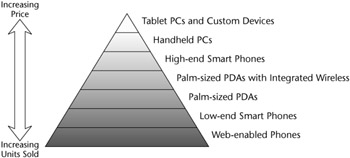
Figure 2.2: Device classifications.
Web-Enabled Phones
Cellular phones are by far the most widely used wireless devices on the market. In some European countries, over 75 percent of the population owns a cellular phone. In most cases, the primary use is voice, but with the introduction of WAP, text messaging, and other wireless Internet technologies, data applications have become much more common. With their widespread popularity, Web-enabled phones become an immediate target for wireless Internet applications.
Figure 2.3 shows a typical Web-enabled phone. As you can see, it provides a very limited display (typically between 4 to 12 lines of text), with the regular 12-button phone keypad for data entry. These limitations make cellular phones a poor choice for surfing the Web, since the amount of data that can be received or input is rather limited. The strength of cellular phones is their widespread use, making them very suitable for targeted applications, often aimed at the consumer market. Some examples include stock quotes, traffic reports, flight updates, ticket purchases, and news headlines. In all of these applications, limited amounts of data are required to get the expected response. The amount of data being retrieved is not overwhelming, so the device can display it in a meaningful format. If, however, you are considering implementing corporate applications, such as sales force and field service automation, a more capable device might be a better choice.
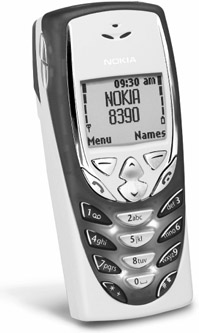
Figure 2.3: Nokia 8390 Web-enabled phone. Image courtesy of Nokia.
As you would expect, cellular phones have built-in wireless modems, making it very easy for users to connect to wireless networks. Once connected, the user can use the modem for either voice calls or data applications; or, using the Wireless Telephony Application (WTA) support in WAP, both voice and data can be used simultaneously. In addition, with the always-on capabilities, cellular phones are ideally suited for text messaging applications. Since these messages are typically limited to 160 characters in length, the input capabilities of these devices is suitable. One other side benefit is the long battery life. With their limited processing power, cellular phones are able to conserve battery power, allowing them to last longer than the more sophisticated devices such as smart phones and PDAs. Keep in mind, however, that the more the device is used for wireless communication, the faster the battery power will be consumed.
The primary use of these devices is for voice access, so quality of voice communication, network coverage, and calling packages usually takes precedence over data services when choosing the best device.
Two-Way Pagers
Two-way pagers are designed for mobile users to exchange short, text-based messages. Very often the applications are loaded by the manufacturer and are not upgradeable. These devices do a great job of paging, but often are not suitable for most sophisticated applications. This is true for most two-way pagers, but there are some exceptions.
RIM and Motorola both offer more advanced paging devices, which provide PDA-like capabilities. They both started out using proprietary operating systems, but this has changed with the advent of J2ME, which both have moved to since. The RIM Blackberry devices and Motorola Timeport pagers have expanded upon the basic paging capabilities by offering support for personal information management (PIM) applications and wireless Internet applications. In addition, they offer advanced user input capabilities using a standard—QWERTY—keyboard that is operated using your thumbs. You can see an example of this in Figure 2.4, which shows the RIM 957 (BlackBerry) and RIM 950.
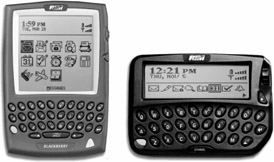
Figure 2.4: RIM two-way pagers. Image courtesy of Research In Motion.
Several microbrowsers are available for these devices, often provided by the company who provides your wireless connectivity. Very often these browsers are WAP-based, using WML as their markup language, although some HTML browsers are available. Since these devices do have a decent means of data input, they are capable of running wireless applications geared at data capture.
One of the most convenient features of two-way pagers is that they are always connected to a wireless network. Users do not have to explicitly connect to a wireless network when they want to access an application. They simply start to use the application and it will transmit the data as required. This is possible because the devices use networks that are packet-switched; users are only charged for the data being transmitted, not per minute as on circuit-switched networks. This feature is required for receiving pages, email, and other types of messages, and also comes in handy for using wireless Internet applications. Also, considering that these devices are always connected to the network, the battery life is quite exceptional, often lasting for weeks without recharging.
Low-End Smart Phones
Smart phones are called such because they provide the ability to run local applications as well as make voice calls. Like Web-enabled phones, these are primarily voice devices, so selection should be based largely on their voice capabilities. The support for applications is somewhat limited due to the constrained storage, processing power, and display sizes. They are similar to Web-enabled devices in form factor and display size, but they provide the ability for applications to run locally without requiring network coverage.
One of the major attractions to smart phones is their simplicity. The average user is able to have her or his device working in minutes without having to worry about extensive configuration. Also, since the devices have very small processors and little memory, they are able to last for days on a single battery charge. Of course, the fact that smart phones offer cell phone capabilities, as well as the support for applications, makes them ideal for those who want to limit the number of devices they have to carry around.
Users can extend the features of the device by downloading new applications over the air. This is called over-the-air (OTA) provisioning. Both handset manufacturers and wireless carriers are creating electronic storefronts where developers can submit their applications for download. Users download applications of interest to them for a nominal fee [usually between $1 and $5 (U.S.)]. The profit is then divided between the developer and the storefront provider.
Much of the interest surrounding the Java 2 Micro Edition (J2ME) is for building applications for these devices. Due to the limitations imposed by the device manufacturers, most m-business applications are not suitable for these devices. At the time this book was written, games were by far the most common applications being downloaded.
Nokia has predicted that it will sell tens of millions of J2ME-based smart phones by the end of 2003. This is not a small number, and presents a very large application development opportunity for J2ME programmers. It also represents a very large number of the new devices that will be coming to market. (Note: This number is only for Nokia devices. Motorola has also released J2ME devices to the market, and a handful of other manufacturers are adopting J2ME as well.)
Palm-Sized PDAs
The palm-sized PDA device is currently in the sweet spot of the mobile device market. This device has touchscreen capabilities for user input. The form factor is in between handheld PCs and smart phones, typically with a one-quarter video graphics array (VGA) screen (320×240), most often in color. The palm-sized PDA has instant on/off capabilities, meaning the device does not have to boot up before being used. The more recent devices on the market also incorporate built-in wireless modems for wireless connectivity. The devices that do not offer a built-in modem usually have an expansion slot into which a wireless modem can be plugged.
The most common devices in this market are the Palm and Pocket PC. Palm devices are currently the market leaders in this category, although their market share lead is shrinking as Pocket PC devices add more capabilities that are well suited for corporate users. Both the Palm and Pocket PC devices have touch-sensitive screens with built-in character recognition support. Palm devices are available in both monochrome and color, while Pocket PCs typically offer color screens. Palm devices are typically somewhat smaller than Pocket PCs, making them very easy to carry around as they can be attached to a belt or easily slipped into a briefcase or purse. They typically weigh around half a pound, or 225 grams.
While the form factor of Palm devices may be attractive, the performance and storage capabilities are often subpar. Many Palm OS-based devices have 8 to 32 megabytes (MB) of total memory and processors running at 33 megahertz (MHz) or less. Historically, this has been acceptable for the applications running on these devices, but as companies roll out enterprise line-of-business applications, this has started to become a problem. As these applications become more advanced, they require more data storage and processing power to meet the application requirements. In addition, as Java applications are deployed on these devices, they require more power to handle the requirements of the Java Virtual Machines (JVMs) and related applications. The new breed of Palm devices running Palm OS 5.0 have overcome this problem by moving to ARM-based processors running at 206 MHz. This puts them on more even ground with the Pocket PC devices on the market.
Most of the Pocket PC-based devices do have slightly better performance characteristics. The latest devices on the market come with between 32 MB and 64 MB of memory along with X-Scale processors running at 400 MHz. The extra computing power is required to run the Windows CE operating system, which is heavier than its Palm OS counterpart. One downside of the increased power is its effect on battery consumption. Palm devices can often last several days on a single battery charge, while Pocket PC devices typically have to be recharged daily.
The original market for many of these devices was as a personal digital assistant, hence the name PDA. Palm grabbed a huge amount of the PDA market by offering an intuitive user interface to access common applications such as calendars, contact lists, and to-do lists. In addition, it has a well-regarded development program to promote the growth of Palm OS-based applications. This broad range of applications, along with the relatively low cost of Palm devices, continues to make Palm OS devices an attractive purchase for many PDA users.
Pocket PC devices came to market a few years after Palm devices, with a different target audience in mind: the high-end PDA audience looking for a rich user interface with multimedia capabilities. These devices of course also target those that wish to be able to use their Microsoft Office products, such as Microsoft Word and Excel, on their PDAs. To accomplish these goals, Pocket PC devices are required to have more hardware capabilities, which also affects the price. In general, most Pocket PC devices are 30 to 50 percent more expensive than Palm OS devices. Although this has started to change with the entry of Dell into the Pocket PC with less expensive devices.
To more clearly distinguish their consumer and enterprise offerings, Palm Inc. have created two subbrands of devices: Tungsten and Zire. The Palm Tungsten family of products is geared for mobile professionals and enterprise work forces. These solutions combine high-powered hardware and software solutions to solve the complex problems IT professionals are faced with. The Palm Zire family of products is aimed at the consumer market, offering low-price devices with easy to use designs. Palm introduced these product families at the end of 2002 with the goal of maintaining their handheld marketshare lead.
When it comes to wireless connectivity, the majority of PDA devices require the modem to be an add-on component. This is usually accomplished by using a sled, or through an expansion slot. In either case, the modem adds extra cost and complexity to the PDA wireless solution. In most cases, users are required to establish a connection to the wireless network when data needs to be transferred and disconnect when they are finished. This means that they are not always connected to the network, so pushing data to the device is more complex.
The manual connection to wireless networks is changing with the introduction of integrated wireless devices such as the Palm i705, shown in Figure 2.5. These devices come with built-in modems for quick and easy data access. These integrated devices are growing in popularity in both the consumer and business markets. The ease of use and always-on network connections make them very attractive choices for a variety of mobile applications.
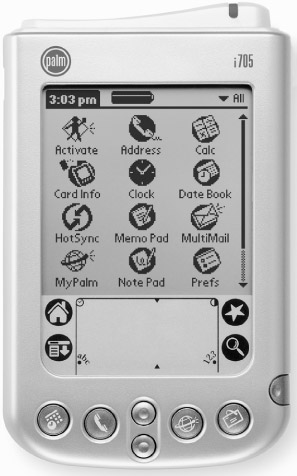
Figure 2.5: Palm i705 with Integrated Wireless. Image courtesy of Palm Inc.
The years to come are going to be very interesting as the PDA device market continues to evolve. Manufacturers are making devices aimed at corporate users who require high-performance devices to deploy more advanced applications. It is at this market that many of the smart client application vendors are targeting their solutions. With the introduction of Windows CE .NET and Palm OS 5.0, it is very clear that this market is going to remain competitive for some time to come. This will only benefit the consumer as exciting new features are constantly being added to attract their attention.
| Note | The market is currently seeing a convergence between PDA devices and voice devices. At the end of 2001 and during 2002, many vendors released combined voice/PDA devices based on the Palm OS. In addition, Pocket PC Phone Edition and Microsoft Smartphone 2002 use Windows CE as their operating system, providing many capabilities present in Pocket PC PDAs with additional voice capabilities. |
High-End Smart Phones
As the wireless application market matures, we are seeing a move toward more capable devices in the form of high-end smart phones. The leading cellular phone manufacturers, including Nokia, Sony Ericsson, and Motorola, among others, are producing these devices, which are targeted at the corporate market. These devices provide the ability for voice communication as well as both thin and smart client applications. This makes them a good choice for people who do not want to carry around multiple devices, but still want support for a variety of applications. Figure 2.6 shows the Sony Ericsson P800 Smartphone in voice and data modes.

Figure 2.6: Sony Ericsson P800 Smartphone. Image courtesy of Sony Ericsson.
The form factor of a smart phone falls in between that of a cell phone and a PDA. They typically have a flip-top mechanism for displaying the full screen and keyboard. When they are closed, they look like a large cellular phone, with the regular 12-digit keypad, and small amount of screen showing. When they are opened, they have screen sizes ranging from 640×200 to 320×240. They also often provide a keyboard for data input. The processors in these devices are powerful enough to run sophisticated local applications as well as advanced wireless Internet applications. The browsers for these devices often have support for color graphics and multimedia, using either WML or HTML as the markup language.
Similar to the two-way pagers and cellular phones, smart phones can often be used for days on a single battery charge. Until recently, the services provided on smart phones were not very customizable. The user was not able to add applications or change the content available on the device. This is changing with some of the latest smart phones, which offer full operating systems with memory available for third-party applications. The most common operating systems in smart phones are Symbian OS, Palm OS, Pocket PC Phone Edition, and Microsoft Smartphone 2002. Support for J2ME is also common.
In North America, smart phones have not been accepted as readily as they have been in Europe and Asia. There are many reasons for this, including wireless network support, the operating systems used, and the manufacturers' marketing and distribution plans. Typically, smart phone manufacturers have been rolling out their new devices in Europe before introducing them to North America. A good example of this is the Nokia Communicator. The Nokia 9210 was released in Europe at the end of 2001, while its counterpart, the Nokia 9290 wasn't released in North America until the middle of 2002.
One thing that may kick-start the smart phone market in North America is Microsoft's entry into the market with its Windows CE-based solution called Microsoft Smartphone 2002. Since it uses the same base operating system as Pocket PC devices, we may start seeing application developers include Microsoft Smartphone 2002 in their supported platforms list.
Another category of device that gets included in the high-end smart phone category is the PDA with integrated voice support. Kyocera and Handspring both have Palm OS devices with integrated voice. RIM has released the BlackBerry 6710/6750 with integrated support for voice communication, and a variety of Pocket PC Phone Edition devices by vendors such as AudioVox and Samsung are now available. These hybrid product offerings are blurring the line between the wireless PDA and the high-end smart phone classes of devices.
Handheld PCs
The concept of the handheld PC is not new. The design can be similar to a laptop, where the screen folds over the keyboard creating a compact shell around the internal device. For this reason, handheld PCs were commonly known as clamshell computers. The original clamshell device came out long before current PDAs were available.
In the mid-1980s, Psion introduced an organizer product that offered the unique capability to run applications. It allowed users to run financial, scientific, and data-driven applications locally on the device. This was in addition to the calculator functions for which it was mainly used. Even though this device was not hugely popular, it laid the foundation for the current line of handheld PCs.
By the early 1990s, Psion released a more functional clamshell computer that had a keyboard as well as a graphical user interface (GUI) screen for running more sophisticated applications. Other companies such as Casio released similar offerings, most often based on a proprietary operating system specific to the device. These operating systems did not support third-party applications, a major limitation. Not long afterward, Microsoft, looking to get a foothold in the PDA operating system market, came out with Windows CE. Most of the companies put aside their proprietary systems and adopted Windows CE as the operating system of choice for their devices, Psion being a notable exception. The specific implementation of Windows CE for devices with this form factor is called the Handheld PC.
Jump to the present day. Now, most Handheld PCs have one-half VGA (480×320) color screens with full keyboards. They have the ability to run a variety of smart client and Web-based applications. In general, Handheld PCs are not used to replace laptops, but rather complement them. The common use of the Handheld PC is not as a general computing device, but rather as an information-gathering device. The one-half VGA screen and integrated keyboard promote rapid data capture, allowing corporations to increase productivity for processes that previously required manual data capture.
There are many benefits of running line-of-business data collection applications to replace paper-based processes: faster, more accurate data collection, increased employee productivity, faster business process transactions, and reduced operational costs. Even though these benefits could be realized using a laptop computer, a hand-held PC is ideal for the job for many reasons. The handheld PCs deliver instant on/off capabilities, making data access immediate. They have a long battery life due to the low power consumption chips used in their design. A single battery charge can often last for an entire day's usage. Additionally, since there are no moving parts, they can handle being knocked around, so can be used in many field environments. These characteristics, along with a smaller form factor than a laptop, make the Handheld PC an ideal device for users who are interested in immediate data access and capture. These devices can host a variety of applications that provide clear benefits for users working away from the office environment. The fact that they often weigh around one pound, or 500 grams, is a nice feature for people who spend a lot of time out of the office.
The handheld PC market has been under pressure from increasingly powerful PDAs and smaller and more efficient laptops. HP is one of the only manufacturers that still sells the clamshell Handheld PC. Other manufacturers have gone with a tablet form factor as illustrated by the Samsung NEXiO in Figure 2.7. The Samsung NEXiO runs Windows .NET 4.1 and has integrated 802.11 capabilities. It is a good example of how handheld PCs have evolved, breathing new life into the handheld PC market.
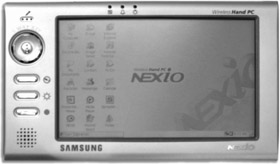
Figure 2.7: Samsung NEXiO Handheld PC.
Tablet PCs
The Tablet PC market is very interesting. Over the past several years, devices in this category have not been terribly successful, and yet Microsoft and its partners are promoting this type of device quite heavily. These devices are aimed at horizontal markets such as field sales and field service, hoping to provide a compelling alternative to a full-blown laptop. Size-wise, they are slightly smaller than a laptop, with some of them having the ability to morph between laptop and tablet layouts. In the laptop position they have a keyboard for data entry; and when in tablet format, they have touch screen, pen-based input. Figure 2.8 shows the Acer TravelMate 100 Tablet PC as it morphs from laptop to tablet mode.
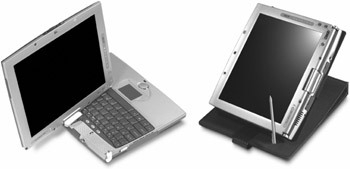
Figure 2.8: Acer TravelMate100 Tablet PC. Image courtesy of Acer.
Microsoft has developed many new applications (such as the Tablet PC Journal) to take advantage of the touch screen features. The journal software allows users to jot down notes and diagrams in their own handwriting, which can then be converted into standard text at the touch of a button. It is like a form of electronic paper.
Tablet PCs run Windows XP as their operating system and have the usual set of laptop add-on peripherals. They also have similar power and storage capacities to laptops. Microsoft is marketing them as an evolution of the laptop, having all of the features of a laptop, with added tablet features and longer battery life.
It is yet to be seen whether the reincarnation of the Tablet PC is here to stay. They do have some attractive features, but until businesses can justify the additional cost and support, laptops will continue to dominate this market.
Notebook/Laptop
In this day and age, laptops are commonplace, and often are not grouped with the other classes of mobile devices. Companies rarely show the benefits of their wireless solution on a full-sized laptop device; they usually prefer to demonstrate the technology using the latest handheld or smart phone to emphasize the small form factors on which the solution is capable of running. In reality, while mobile applications are capable of running on handheld devices, they are often deployed to laptop computers. For this reason, laptop computers are included in the mobile device classification in this chapter. Laptop computers offer many benefits for mobile applications: They run the same operating systems that users are accustomed to on their desktop computer; they can run the same applications as the desktop computers; and they have the same computing power that users experience on their desktop computers. So the laptop is really just a portable desktop computer, with few restrictions as to what types of applications can be executed. This makes it very easy for IT departments to build laptop applications for the company's mobile users.
Many of the Customer Relationship Management (CRM) and mobile Enterprise Resource Planning (ERP) applications that are currently deployed are laptop-based. Yes, there are now versions coming out targeted at the sub-laptop market, but the current deployments are mainly on laptops. As discussed previously, this is because the application does not have to be altered for deployment on the laptop. Implementing a mobile application on a laptop is as straightforward as implementing a desktop client/server-based application. The developer does not have to be concerned with limited screen sizes, memory, or processing power.
Most laptops on the market today have equivalent capabilities when compared to desktop computers. They have processors running around 2 gigahertz (GHz); they have 60-gigabyte (GB) hard drives; and they have 256 to 512 MB of RAM. In addition, they have full keyboards, 14-inch display screens, and CD-ROM or DVD drives. They include everything that a user requires when away from the office.
One of the major downsides to laptops is their weight and size. Even the lightest machines weigh 2 to 4 pounds, or 1 to 2 kilograms. They also require the user to carry around a separate bag or case, whereas many PDAs can be stored in a pocket or purse, or even clipped to a belt.
When making your device selection, do not limit yourself to the handheld mobile device market when a laptop may meet your requirements for size at the same time as providing excellent performance. At the same time, laptop computers do cost significantly more than the smaller devices, so if the smaller device does meet the needs of the end user, it may be more cost-effective and convenient to use.
|
|
EAN: 2147483647
Pages: 148